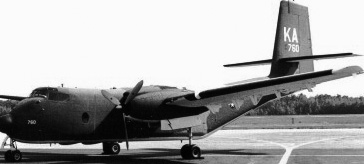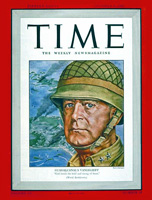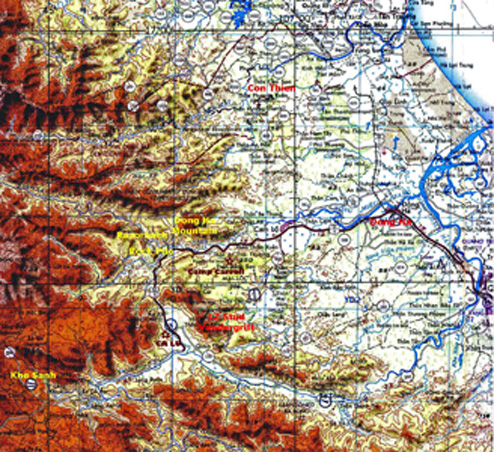LZ Stud
(LZ Vandegrift)
Upon our arrival at Camp Eagle, I was assigned the position of accompanying a Warrent Officer and a Vietnamese soldier to a location located about 10 miles from the DMZ called LZ Stud which was later changed to LZ Vandegrift. At the time I was there, it was mostly composed of army personnel and later became a marine base.

LZ Stud location
I was called to the orderly room and told by Top Sergeant Shorter to get my gear ready and report to a Warrent Officer whose name I can't remember. I would be driving a 3/4 ton truck with commo hut and trailer via convoy to an undisclosed location. I traveled pretty light so I was ready quickly.
We joined our convoy and were on our way. The weather at the time was dry so we inhaled quite a bit of dust as the convoy proceeded. The vehicle that was assigned to us was less than in good shape. It had a problem with the brakes in that they were not the greatest. We were given this vehicle specifically because it wasn't expected to return to Camp Eagle. Our convoy of vehicles made its way north through the city of Hue. I was utterly awestruck at the destruction of the city. It looked as though someone had taken a bull dozer and pushed piles of rubble out of the way to allow the passage of traffic. No matter where I looked, any clarity of organization could not be seen. Many years later, I had a conversation with a young man who was complaining about what a mess our city had become. My reply to him was that he'd never know what a mess could be.
Along the way, we began to take some mortar rounds and were required to speed up our pace. It was at this point that the brakes became a problem. Coming out of a cloud of dust, here was this 2.5 ton truck stopped in the road. I came within a few inches of driving into the rear of it. As we were attempting to remove ourselves from the danger area, the striking mortar rounds could be heard but were muffled. As I looked to my right at one point, I counted three rounds falling into a dry creek bed that was soft sand. The rounds embedded themselves deep into the sand were prevented from projecting their metal shards. Had the ground been of a hard substance, we probably would have taken some hits. I can see that moment like a movie reel playing.
We arrived at our operation location which had been placed on a hill overlooking the runway which was in the process of being built. A sign had been placed on the concertina wire that stated: "Never piss into the wind". The only aircraft coming and going at this point were Hueys and Chinooks. It was not until the completion of the runway that I witnessed the first fixed wing aircraft come in and land. I think that it was a plane called the Caribou:

I believe that most of us that served went to where we were ordered and didn't know the big picture of our exact locations. I know that for me this was true. I had a basic idea but no real specifics. It wasn't until years later when I read the book "Battle for Khe Sanh" that I had the realization of the significance of my duty location. My duty took me to Camp Carol and Camp Evans due to my flight hopping required to get back to Camp Eagle. For this reason, I've included some pictures of maps that I've found on the internet. If I have used any copyrighted material, please contact me and it will be removed.
My job was was to attempt repair on our radios and tape recorders. I use the word attempt because I had but a small toolbox and no spare parts. Any repair that was more but a bailing wire fix had to be made back at our base camp. For that reason, my job turned into that of a courier. Our tape decks were constantly going down and needed to be switched out for workable ones. I would not only shuttle the taped information to Phu Bai for translation but would load up with the broken tape decks. Sometimes I would have two of these strapped to my ruck sack. They were heavy enough that I would have to lie down on top of the ruck sack and have help to get to my feet. Once standing, I could shoulder the weight.
I carried a set of orders that gave me priority on all flights with space. I bumped a "Full Bull" Colonel off a flight one day. He wasn't real happy with me as he was headed for R&R. He tried to order me to take the next flight but my orders trumped his "Bird". I didn't feel good about the situation but I knew that I had to follow my instructions. As he walked away, I heard that I was generally a "no good....%^%$%".
Generally, I would ride the rail sitting next to the side gunner with one arm wrapped around the aluminum post that outlined his position. It was definitely an interesting time. Whenever possible, the pilots would fly the rivers just above the water. The view was absolutely outstanding as we moved through the blur of colors. Sometimes we would fly at a higher altitude. From this vantage point could be seen the many craters where bombs had fallen.
One one flight, everything was going well when I heard several "pop,pop,pop" sounds and the pilot pulled back on the stick and it felt as though we were headed straight up. The blades bit into the air and we immediately gained a lot of altitude. We got back to Camp Eagle and no explanation was given for our erratically flight maneuver. Recently, I told this story to one of our VFW members who was a Huey pilot. He explained to me that the sound that I heard were rounds going through the chopper. Whew!
In retrospect, I probably wasn't very smart when it came to my personal safety. I rarely ever wore my flak jacket or steel pot. Mostly, I wore my "boonie hat". While flying courier, I carried 30 magazines of ammo and my canteen of water. I always figured that if we went down that the enemy would be all over the crash site. I felt that if I survived the impact of the crash that I should be the biggest "pain in the ass" to our opponents possible.
"It had its beginning in March 1968 as a landing strip and a helicopter landing pad. Then, known as LZ Stud, it served as a jumping off point for operations to open Rte. 9 leading to Khe Sanh. During this operation, helicopters flew from the landing strip, just off Rte. 9, to re-supply Marine and Army units moving into Khe Sanh. After the operation, the activity at LZ Stud, just 10 miles from the DMZ, soon died down. The centrally located landing strip had its rebirth when Khe Sanh Combat Base was officially closed in June 1968 and the 3rd Marine Division turned to employ its technique of mobility. Named after the 18th Commandant of the Marine Corps and Medal of Honor winner, General Alexander A. Vandegrift......."

..............GySgt. John Conick.

I've always admired some of the strange things that go on when people of different ideologies can come together and/or share a bit of humanity amidst the brutality and down right meanness toward one another during wartime. It is a well known fact that during the war in Africa during WW2, there was a German commander who would radio the English and let his enemy know who had been captured or killed. Again, there are stories of pilots from different nationalities who chose not to kill their opposite number out of respect. Although I know many fellow American soldiers who have a strong respect for those who opposed us in Vietnam, the following is an email that was sent to me by my friend Doug Bonner of the Sentinels after we had been discussing LZ Stud which became LZ Vandegrift:
I've been to Vandegrift - it was turned into an aircraft refueling point. I'm not 100 per cent
certain but I think that was probably the only point on the map where the US/ARVN and the NVA
cooperated. During the heaviest fighting of Lam Son 719 it did not get shelled until very late
in the operation. It was such a lucrative target - and arty and rockets fell on everything nearby.
I couldn't figure out why until I was there one day en route between Quang Tri and Khe Sanh.
I saw what looked like an H-34 Choctaw refueling - I thought it was an ARVN Marine helicopter
until I noticed the little red star below the pilot's window.
We gave the NVA gas, they didn't shoot . . . a small price to pay.
The lam son 719 was between 8 February and 25 March 1971.
BACK TO CAMP EAGLE